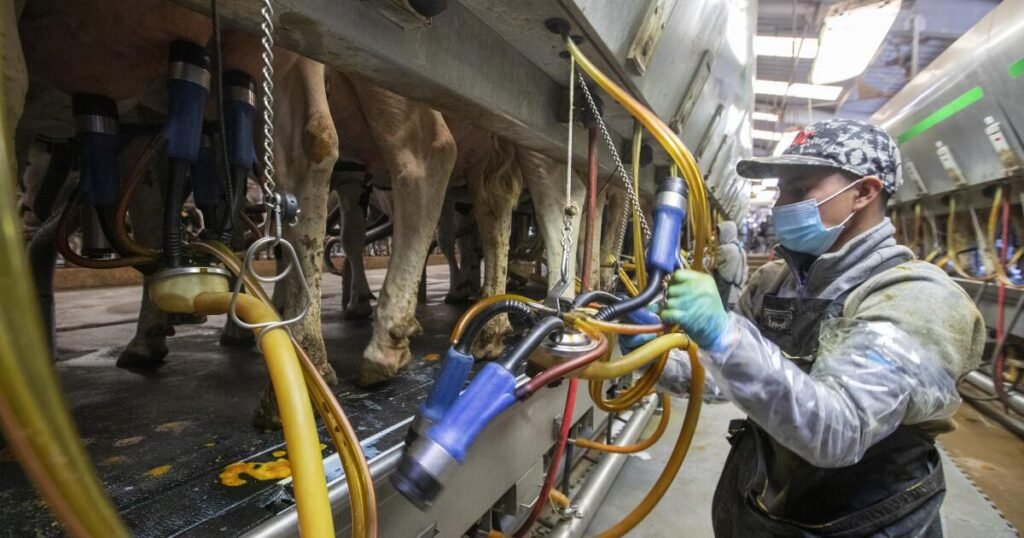Concerns About Avian Flu Resurgence This Fall
Officials are bracing for a possible resurgence of avian flu cases this fall, but infectious disease specialists caution that the Trump administration’s strict immigration policies could complicate efforts to control the spread of the virus.
According to the Centers for Disease Control and Prevention (CDC), most confirmed infections from H5N1 avian influenza have occurred among dairy and poultry workers, with 65 out of 70 reported cases linked to this group.
Immigration plays a significant role in the agricultural workforce, and many of these workers, as stated by industry representatives and scholars, likely entered the U.S. undocumented. This situation could lead to difficulties in managing future outbreaks, as many workers are hesitant to engage with health officials.
“Few dairy and poultry workers, regardless of their immigration status, will openly seek help if they believe they might have H5N1,” noted Angela Rasmussen, a virologist from the University of Saskatchewan. “Most will just keep quiet about their symptoms,” she explained.
While USDA officials have not commented on this issue, California’s Department of Public Health has initiated testing with some incentives, like $25 gift cards for participants, and is providing personal protective gear to workers and farmers.
A spokesperson for the Department of Health and Human Services suggested that claims about immigration policies hindering disease reporting are unfounded, emphasizing that the work being done is backed by evidence.
Public health officials assess the general risk of H5N1 infection for the broader population as low, though those working closely with livestock and wildlife are at a higher risk.
Recently, the Trump administration reversed its earlier decision to halt immigrant arrests at farms and healthcare facilities. This month, Agriculture Secretary Brook Rollins stated that there would be no amnesty for undocumented workers.
Jennifer Nuzzo, director of Brown University’s Pandemic Center, highlights two primary concerns arising from these immigration policies. Dairy and poultry workers are often the first to encounter the virus, and if they fear reporting symptoms or getting tested, it could lead to greater risks. “Early intervention is crucial,” she noted, pointing out the need for quick action when symptoms arise.
Furthermore, she mentioned that these crackdowns could also limit the detection of potential pandemics. “For a pandemic to start, the virus must spread easily between people. But if cases go unreported, tracking becomes nearly impossible,” she stated.
There were arrests of undocumented dairy workers in Vermont last spring, resulting in deportations that sent ripples through the local dairy industry.
Anja Raudabaugh, leader of California’s largest dairy trade group, expressed confidence in current safety measures and protocols to manage avian flu. She believes the state is better prepared than last year.
Raudabaugh observed that occupational clinics now have access to necessary testing equipment and that antiviral medications are available, improving the state’s response capabilities.
Interestingly, many dairy trade groups do not challenge the immigration policies. As Raudabaugh puts it, “Dairy farmers are eager to be part of the solution.” She emphasized the stable nature of dairy jobs and the positive work environment.
Meanwhile, farmer Joey Ierso mentioned that when his dairy experienced an outbreak last year, the overall impact on his operation was minimal, although he expressed concerns about border security and its implications.
In contrast, Mark McAfee, a neighboring farmer, shared his anxieties about both the potential for future outbreaks and the risk of immigration enforcement affecting his workforce.
Looking ahead, it remains uncertain whether another widespread avian flu outbreak will occur this season. Although there have been only a few isolated cases recently detected, experts believe this could change as migratory birds arrive.
“Currently, there are about 60,000 waterfowl in California, but that number can rise dramatically in late fall,” explained Maurice Pitsky, a poultry expert. These birds are key carriers of the virus.
Since the resurgence of the virus in late 2022, it has led to various outbreaks in poultry and other wildlife. The concern continues as new variants can emerge.
Andrew Lammy, a researcher at the U.S. Geological Survey, is closely monitoring the situation in wild bird populations and noted that the coming weeks could reveal more about the virus’s potential evolution.
“We’re all keeping a close watch this fall,” he commented.







